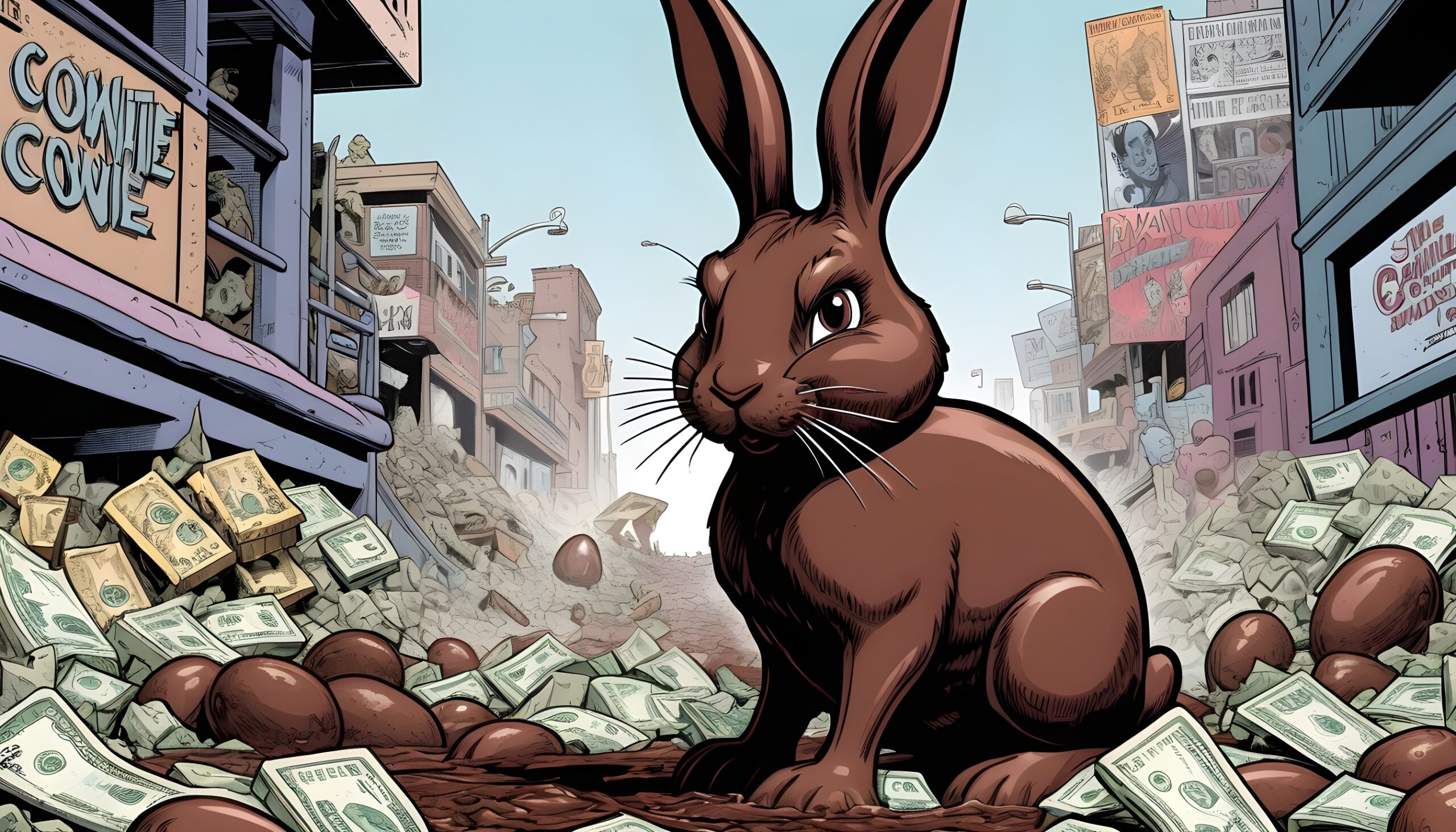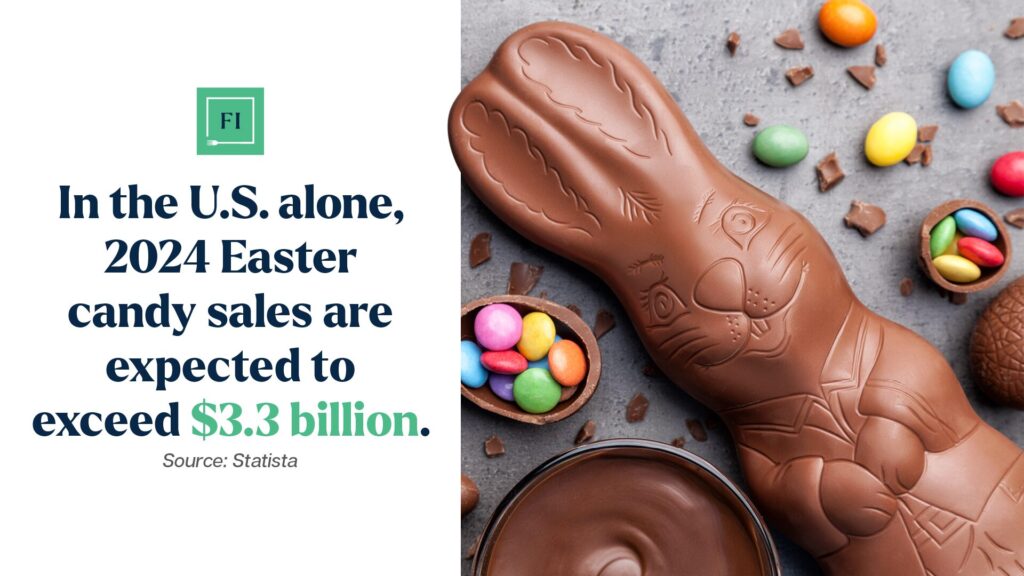Consumers may have to tone down the Easter egg hunt this year, especially if chocolate is involved. New York cocoa futures recently hit a 46-year high, and analysts believe there’s even more room to squeeze a few more pennies out of pockets due to one simple fact:
Demand for chocolate remains as steady as ever.
Chocolate exists on the same plane as coffee – when you need it, you need it, and it’s readily available from almost every store, grocer, and retailer in every town across the country. In West Africa, however, home to 75% of the world’s cocoa production, concerns over the global supply of chocolate have pushed prices through the roof.
“You could say that one of the reasons we’ve seen cocoa hold up fairly well in terms of demand is it is arguably a compulsive purchase for consumers,” said Paul Joules, commodities analyst at Rabobank, to CNBC, “so we don’t really see it have the same sort of demand dynamics as many other commodities.”
The demand is so tight that Hershey – one of if not the most recognizable chocolate company in the world – issued a profit warning last month to its shareholders regarding soaring cocoa prices, warning that ever-increasing cocoa prices may diminish earnings growth later this year.
Cocoa futures recently surpassed $9,000 per ton for the first time ever, catapulting over another commodity for one truly bizarre fact:
Cocoa is now more expensive than copper.
“Consumer behavior during holidays is pretty predictable. It’s an expected expense for households – they’re going to fill the Easter basket. It’s a holiday, it’s indulgent, and people are going to spend,” said Andy Keenan, executive vice president and general manager at Advantage Solutions, to TFI.
“Because the price of chocolate remains at an all-time high, I expect to start to see more consumers pivoting to non-chocolate sweets as we get closer to Easter, which would mark a big change because chocolate always wins Easter.”
For those who don’t regularly indulge their sweet tooth, the data may come as something of a shock – cocoa prices are over 65% higher than they were one year ago. Yet demand remains high even as dollar sales of chocolate confections grew in 2023 due to manufacturer price increases. Recent data from the National Confectioners Association (NCA) highlighted the fact that 74% of American consumers consider confectionary items as affordable treats, however, 45% of consumers have begun to change their candy-consuming habits and have either switched types, brands, pack sizes, even their entire preferred retailer.
Recent data from NCA notes that confectionary sales drive the economy in the spring by generating over $5 billion of revenue each year, and 92% of Americans who celebrate Easter plan to include chocolate and/or candy in their celebrations.
John Downs, president and CEO of NCA, notes, “The Easter season signals the start of spring – and is a perfect showcase of the continued excitement consumers have for incorporating chocolate and candy into their special occasions. No matter what treats they prefer, Americans can agree that every celebration is sweeter with chocolate and candy.”
That sweetness costs more this year, however, and the situation is exacerbated by El Nińo, a weather pattern that typically brings unseasonably warmer temperatures to many temperate regions around the globe. Because cocoa trees only grow within 20 degrees north and south of the equator, the cocoa supply is especially vulnerable to adverse conditions with a thin margin of error. Last year, the West African coast experienced above-average rainfall, resulting in increased disease issues while previous El Nińo years saw the opposite effect – unseasonably drier conditions.
According to a recent report from the Wells Fargo Agri-Food Institute, the International Cocoa Organization (ICCO) recently projected cocoa production through 2024 to fall by as much as 11% year-over-year to 4.45 million metric tons; global cocoa grindings will also fall nearly 5% in the same period, resulting in a 405% increase in the global deficit.
Wells Fargo sector manager David Branch said, “With cocoa harvests coming up short for the third year in a row, it is likely that cocoa prices will remain high at least through the next crop year (2024/2025).”
“While chocolate is still going to win, if you look at year-over-year growth post-holiday, I’d expect we’re going to see more growth in non-chocolate sweets,” Keenan added. “Why? Consumers are very price-conscious, now more than ever. And the price of chocolate is driving that. It’s been a long burn.
“Consumers experienced higher prices during Halloween and Valentine’s Day, and I think we’re at the point now where we’re going to see some shifting into non-chocolate sweets.”
Kroger recently released its 2024 top Easter candies, and most if not all should fetch top Easter prices due to dwindling cocoa supplies and the inflation-ridden sugar market.
Kroger’s Top Easter Candies, 2024
- Reese’s Eggs
- Cadbury Mini Eggs
- Lindt Milk Chocolate Gold Bunny
- Starburst Jellybeans
- Cadbury Crème Eggs
- Whoppers Robin Eggs
- Peeps® Chicks and Bunnies
- M&M’s Easter Milk Chocolate Candy
- Kinder Joy Eggs
- Brach’s Classic Jelly Bird Eggs
To drill down a little further, here’s an interactive map from Candystore.com featuring each state’s top three Easter candies:
How much money is the Easter candy market worth? Hold onto your Easter baskets – in the United States alone, 2024 Easter candy sales are expected to exceed $3.3 billion (Statista). The U.S. is also the global leader in terms of the confectionary market, netting about $191 billion each year, followed by Japan, China, and India (also Statista).
Chocolate eggs are the most popular candy, easily outpacing bunnies and jelly beans. And as in Halloween several months before it, one brand reigns supreme – Reese’s Peanut Butter Eggs are found the most in baskets (and tucked away during hunts).
Since over 90 million chocolate Easter bunnies are produced each year, one can only imagine how many Reese’s Peanut Butter Eggs hit the market – and how much more expensive they’re poised to become.













